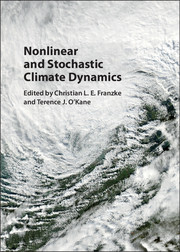Book contents
- Frontmatter
- Contents
- List of Figures
- List of Contributors
- Preface
- 1 Challenges for Ice Age Dynamics: A Dynamical Systems Perspective
- 2 Tipping Points in the Climate System
- 3 Atmospheric Teleconnection Patterns
- 4 Atmospheric Regimes: The Link between Weather and the Large-Scale Circulation
- 5 Low-Frequency Regime Transitions and Predictability of Regimes in a Barotropic Model
- 6 Complex Network Techniques for Climatological Data Analysis
- 7 On Inference and Validation of Causality Relations in Climate Teleconnections
- 8 Stochastic Climate Theory
- 9 Stochastic Subgrid Modelling for Geophysical and Three-Dimensional Turbulence
- 10 Model Error in Data Assimilation
- 11 Long-Term Memory in Climate: Detection, Extreme Events, and Significance of Trends
- 12 Fractional Stochastic Models for Heavy Tailed, and Long-Range Dependent, Fluctuations in Physical Systems
- 13 Modelling Spatial Extremes Using Max-Stable Processes
- 14 Extreme Value Analysis in Dynamical Systems: Two Case Studies
- Index
12 - Fractional Stochastic Models for Heavy Tailed, and Long-Range Dependent, Fluctuations in Physical Systems
Published online by Cambridge University Press: 26 January 2017
- Frontmatter
- Contents
- List of Figures
- List of Contributors
- Preface
- 1 Challenges for Ice Age Dynamics: A Dynamical Systems Perspective
- 2 Tipping Points in the Climate System
- 3 Atmospheric Teleconnection Patterns
- 4 Atmospheric Regimes: The Link between Weather and the Large-Scale Circulation
- 5 Low-Frequency Regime Transitions and Predictability of Regimes in a Barotropic Model
- 6 Complex Network Techniques for Climatological Data Analysis
- 7 On Inference and Validation of Causality Relations in Climate Teleconnections
- 8 Stochastic Climate Theory
- 9 Stochastic Subgrid Modelling for Geophysical and Three-Dimensional Turbulence
- 10 Model Error in Data Assimilation
- 11 Long-Term Memory in Climate: Detection, Extreme Events, and Significance of Trends
- 12 Fractional Stochastic Models for Heavy Tailed, and Long-Range Dependent, Fluctuations in Physical Systems
- 13 Modelling Spatial Extremes Using Max-Stable Processes
- 14 Extreme Value Analysis in Dynamical Systems: Two Case Studies
- Index
Summary
Abstract
A series of pioneering papers by Mandelbrot and his colleagues in the 1960s and early 1970s identified three effects present in many fluctuating time series drawn from observations in both the natural and the economic sciences, and put forward a mathematical model to describe each one. The effects were heavy tails in the amplitude of fluctuations, long range dependence, and autocorrelation between the absolute values of a time series. The effects have broad importance, with applications ranging across climate science in areas as diverse as the heavy tailed distributions of intense rainfall, the recurrence times between droughts, the clustering of extreme wind storms and the intermittent, bursty, volatility seen in fluid turbulence. Each effect exemplifies a very strong departure from one of the key properties of Gaussian white noise. They also greatly increased the visibility of the notions of self-similarity, power laws, and fractional calculus in physics. In this chapter I will summarise the three effects together, in order to compare and contrast them, and then go on to explain the reasons they were introduced, and the tools needed to understand and apply them.
Introduction
Why stochastic models for climate: At least two streams of theoretical investigation have contributed greatly to our present-day understanding of climate. One very visible one has been the global circulation models which solve fluid equations computationally, with appropriate closure schemes (Houghton, 1986). Another stream, perhaps less visible outside the climate community but nonetheless very important, has been the more minimalist approaches, such as the energy balance models which encode as few assumptions as possible in order to study properties such as the latitudinal dependence of temperature (Ghil, 1984). Both streams are deterministic, but the pioneering work of Hasselmann (1976) and Leith (1975) has led to a third group of approaches, reviewed by Gottwald et al. (2016), which face the irreducible complexity of the climate system by mixing deterministic and random components. These can be seen as modelling both the “centre of mass” and the fluctuations of a system's trajectory in the appropriate variable, such as temperature.
- Type
- Chapter
- Information
- Nonlinear and Stochastic Climate Dynamics , pp. 340 - 368Publisher: Cambridge University PressPrint publication year: 2017
- 3
- Cited by



